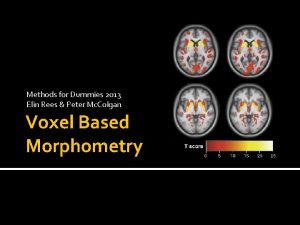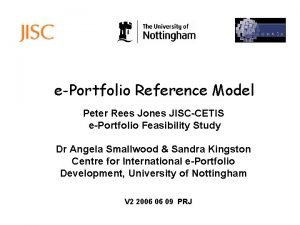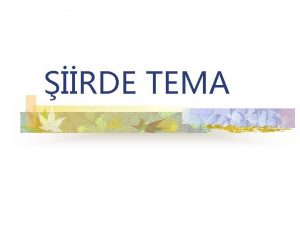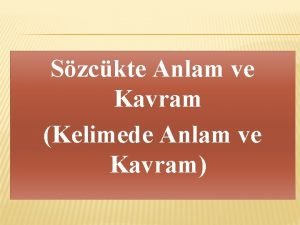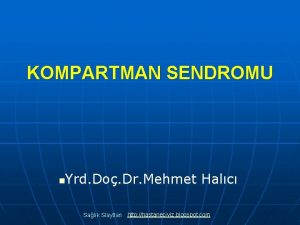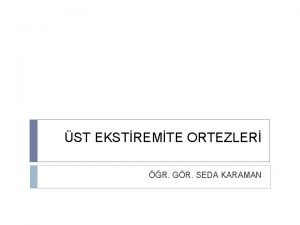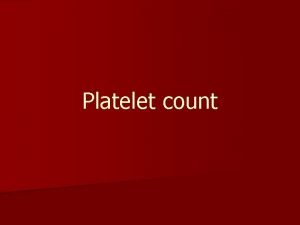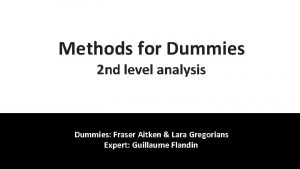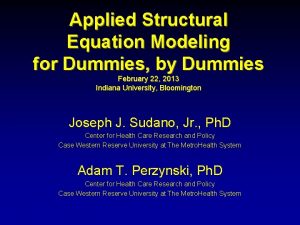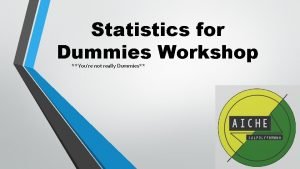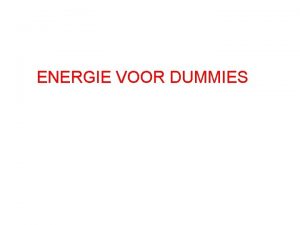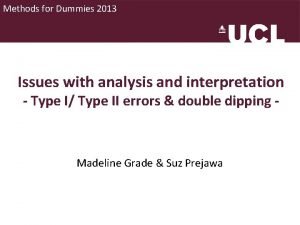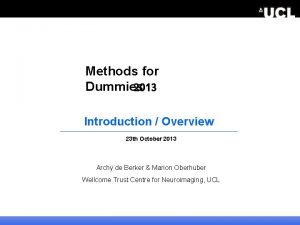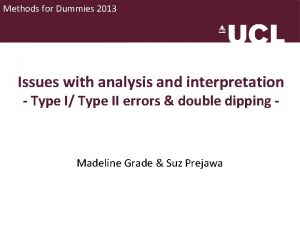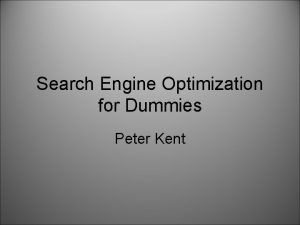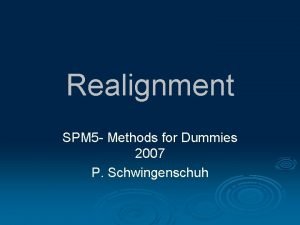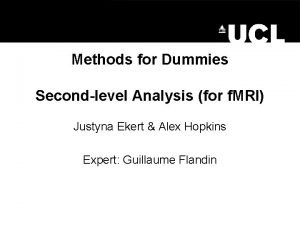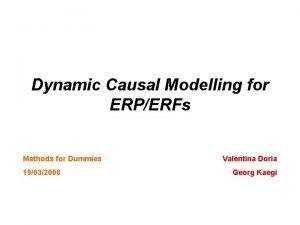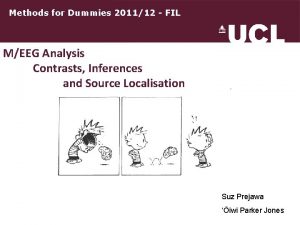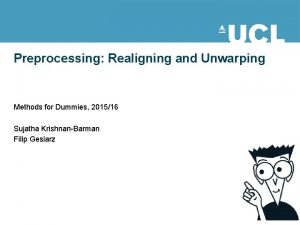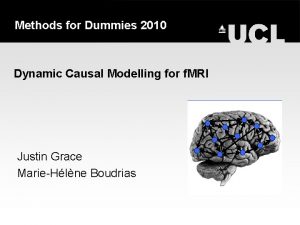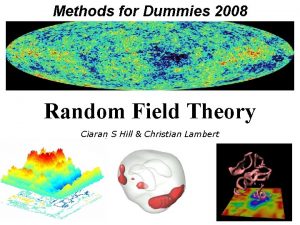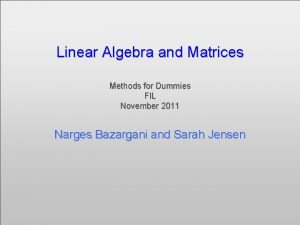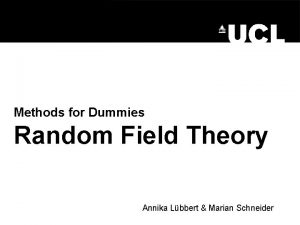Methods for Dummies 2013 Elin Rees Peter Mc
























- Slides: 24

Methods for Dummies 2013 Elin Rees & Peter Mc. Colgan Voxel Based Morphometry

Contents � General idea � Pre-Processing Spatial normalisation • • • Segmentation Modulation Smoothing � Statistical analysis GLM Group comparisons Correlations • Longitudinal fluids Interpretation Issues • Multiple comparisons • Controlling for TIV • Global or local change • Interpreting results Summary

General Idea � Uses Statistical Parametric Mapping software � ‘Unbiased’ technique � Pre-processing to align all images � Parametric statistics at each point within the image Mass-univariate � Statistical parametric map showing e. g. differences between groups regions where there is a significant correlation with a clinical measure

Pre-Processing: Unified Segmentation = iterative tissue classification + normalisation + bias correction � Segmentation: ▪ Models the intensity distributions by a mixture of Gaussians, but using tissue probability map (TPM) to weight the classification ▪ TPM = priors of where to expect certain tissue types ▪ Affine registration of scan to TPM � Normalisation: The transform used to align the image to the TPM used to normalise the scan to standard (TPM) space ▪ parameters calculated but not applied Corrects for global brain shape differences �Bias correction: Spatially smoothes the intensity variability, which is worse at higher field strengths

DARTEL = Diffeomorphic Anatomical Registration using Exponentiated Lie algebra registration � Registration of GM segmentations to a standard space 1) Applies affine parameters into TPM space 2) Additional non-linear warp to study specific space � Study-specific grey matter template � Constructs a flow field so one image can slowly ‘flow’ into another � Allows for more precise inter-subject alignment � Involves prior knowledge e. g. stretches, scales, shifts and warps

Pre-Processing: Modulation � Spatial normalisation removes differences between scans � Modulation of segmentations puts this information back � Rescaling the intensities dependent on the amount of expansion/contraction - if not much change needed, not much intensity change E. g. Native = Unmodulated warped = Modulated = 1 2/3 1 1 1/3 1 2/3 = lower in the middle where imaged stretched but total is preserved.

Pre-Processing: Smoothing • Gets rid of roughness and noise to produce data in a more normal distribution • Removes some registration errors • Kernel defined in terms of FWHM (full width at half maximum) of filter • 7 -14 mm kernel • Analysis is most sensitive to effects that match the shape and size of the kernel • Match Filter Theorem • Kernel takes weighted average of the surrounding intensities • Smaller kernels mean results can be localised to a more precise region • Less smoothing needed if DARTEL used • In an ideal world this would not be needed

Results � Voxel-wise (mass-univariate) independent statistical tests for every single voxel � Group comparison: Regions of difference between groups � Correlation: Region of association with test score

Statistical Analysis �Test group differences in e. g. grey matter BUT � Ridgeway et al. 2008: Ten simple rules for reporting voxel-based morphometry studies � which covariates e. g. age, gender etc. ? which search volume? what threshold? correction for multiple comparisons? Multiple methodological options available Decisions must be clearly described Henley et al. 2009: Pitfalls in the Use of Voxel-Based Morphometry as a Biomarker: Examples from Huntington Disease

Statistical Analysis �GLM � Y = Xβ + ε Intensity for each voxel (V) is a function that models the different things that account for differences between scans: V = β 1(Subject A) + β 2(Subject B) + β 3(covariates) + β 4(global volume) + μ + ε V = β 1(test score) + β 2(age) + β 3(gender) + β 4(global volume) + μ + ε

Statistical Analysis �SPM � Mass univariate independent statistical tests for every voxel ~ 1000, 000 Regions of significantly less grey matter intensity between subjects and controls Regions showing a significant correlation with test score or clinical measure

Statistical Analysis �Multiple Comparisons � Introducing false positives when dealing with one than one statistical comparison � One t-test with p <. 05 a 5% chance of (at least) one false positive � 3 t-tests, all at p <. 05 All have 5% chance of a false positive So actually you have 3 x 5% chance of a false positive = 15% chance of introducing a false positive

Statistical Analysis �How big is the problem? � In VBM, depending on your resolution 1000000 voxels 1000000 statistical tests � do the maths at p <. 05! 50000 false positives � So what to do? Bonferroni Correction Random Field Theory/ Family-wise error False Discovery Rate Small Volume Correction

Statistical Analysis Bonferroni-Correction (controls false positives at individual voxel level): divide desired p value by number of comparisons . 05/1000000 = p < 0. 00000005 at every single voxel Not a brilliant solution (false negatives) Added problem of spatial correlation data from one voxel will tend to be similar to data from nearby voxels

Statistical Analysis Family Wise Error (FWE) Probability that one or more of the significance tests results is a false positive within the volume of interest SPM uses Gaussian Random Field Theory (GRFT) GRFT finds right threshold for a smooth statistical map which gives the required FWE. It controls the number of false positive regions rather than voxels Allows multiple non-independent tests

Statistical Analysis False Discovery Rate Controls the expected proportion of false positives among suprathreshold voxels only Using FDR, q<0. 05: we expect 5% of the voxels for each SPM to be false positives (1, 000 voxels) Bad: less stringent than FWE so more false positives Good: fewer false negatives (i. e. more true positives) More lenient may be better for smaller studies

Statistical Analysis Small Volume Correction Hypothesis driven and ideally based on previous work Place regions of interest over particular structures Reduces the number of comparisons Increases the chance of identifying significant voxels in a ROI

Other Issues in VBM Controlling for total intracranial volume (TIV) � Uniformly bigger brains may have uniformly more GM/ WM brain A brain B Differences without accounting for TIV brain A brain B differences after TIV has been “covaried out” (Differences uniformally distributed with hardly any impact at local level)

Other Issues in VBM Global or local change With TIV: greater volume in A relative to B only in the thin area on the right-hand side Without TIV: greater volume in B relative to A except in the thin area on the righthand side Including total GM or WM volume as a covariate adjusts for global atrophy and looks for regionally-specific changes

Other Issues in VBM Interpretation

Other Issues in VBM Longitudinal Analysis: Fluid Registration Baseline and follow-up image are registered together non-linearly Voxels at follow-up are warped to voxels at baseline Represented visually as a voxel compression map showing regions of contraction and expansion contracting expanding

Limitations Small volume structures: Hippocampus and Caudate, issues with normalisation and alignment VBM in degenerative brain disease: normalisation, segementation and smoothing of atrophied scans

Summary Advantages Disadvantages Fully automated: quick and not susceptible to human error and inconsistencies Unbiased and objective Not based on regions of interests; more exploratory Picks up on differences/ changes at a global and local scale Has highlighted structural differences and changes between groups of people as well as over time Data collection constraints (exactly the same way) Statistical challenges Results may be flawed by preprocessing steps Underlying cause of difference unknown Interpretation of data- what are these changes when they are not volumetric?

Questions ?
 Elin rees
Elin rees Peter rees facebook
Peter rees facebook Peter rees jones
Peter rees jones Gravity for dummies and dummies for gravity equations
Gravity for dummies and dummies for gravity equations Epiteelikudos
Epiteelikudos Elin sternberg
Elin sternberg Elin kjelsaas rogndokken
Elin kjelsaas rogndokken Elin stangeland
Elin stangeland Elin brock
Elin brock Elin arntsen
Elin arntsen Elin priks
Elin priks Elin kapısında karavaş olan
Elin kapısında karavaş olan Ella liljegren
Ella liljegren Doğadan doğaya aktarma nedir
Doğadan doğaya aktarma nedir Per jordal
Per jordal Elin lerum boasson
Elin lerum boasson Fasiyotomi
Fasiyotomi Elin dilenci konumu nedir
Elin dilenci konumu nedir Radial sinir hasarı
Radial sinir hasarı Gymnasium rees
Gymnasium rees Andrea rees davies
Andrea rees davies Mapleson jackson rees circuit
Mapleson jackson rees circuit Dr megan rees
Dr megan rees Brecher cronkite
Brecher cronkite Victoria rees net worth
Victoria rees net worth
